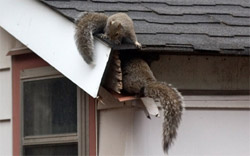Wildlife Facts
 Raccoons – As with all species of in nature, Raccoons have a role to play and they do benefit us. Raccoons are omnivores and will eat just about anything. Their diet consists of plants, berries, roots, rodents of all kinds, fruits and marine life if near water. Rodents make up a large part of their diet,so having Raccoons patrolling your neighborhood should be looked at as nature’s own pest control. Just keep your garbage secure and your pet doors locked at night!
Raccoons – As with all species of in nature, Raccoons have a role to play and they do benefit us. Raccoons are omnivores and will eat just about anything. Their diet consists of plants, berries, roots, rodents of all kinds, fruits and marine life if near water. Rodents make up a large part of their diet,so having Raccoons patrolling your neighborhood should be looked at as nature’s own pest control. Just keep your garbage secure and your pet doors locked at night!
 Skunks – Everything in nature has a role or purpose, and skunks are no exception. Skunks are omnivores, and their diets vary with the season. A skunk’s diet consists of small rodents, lizards, insects, berries, roots, grasses, carrion, slugs, snails, larvae, unsecured garbage, and pet food left outside by humans. Skunks themselves are the favorite meal of the great horned owl. Great horned owls have a very poor sense of smell and are not affected by the noxious odor that is the skunk’s only defense.
Skunks – Everything in nature has a role or purpose, and skunks are no exception. Skunks are omnivores, and their diets vary with the season. A skunk’s diet consists of small rodents, lizards, insects, berries, roots, grasses, carrion, slugs, snails, larvae, unsecured garbage, and pet food left outside by humans. Skunks themselves are the favorite meal of the great horned owl. Great horned owls have a very poor sense of smell and are not affected by the noxious odor that is the skunk’s only defense.
 Bats – For many reasons, many people wish to have colonies of bats removed from the building. Please be aware that this is a specialty service. Some bats live in buildings, and there s no reason to evict them if there is little chance for contact with people. Bats must not be allowed into your home. It s best to contact us for assistance with “bat-proofing” your home.
Bats – For many reasons, many people wish to have colonies of bats removed from the building. Please be aware that this is a specialty service. Some bats live in buildings, and there s no reason to evict them if there is little chance for contact with people. Bats must not be allowed into your home. It s best to contact us for assistance with “bat-proofing” your home.
 Small Animals – Whether outside or indoors, the critters that scurry, climb, fly, and burrow on our properties can be a nuisance. In some cases, these unwanted guests can actually pose a danger to the structure of our homes, or even the health of the people who live in them. Fortunately we are here to help.
Small Animals – Whether outside or indoors, the critters that scurry, climb, fly, and burrow on our properties can be a nuisance. In some cases, these unwanted guests can actually pose a danger to the structure of our homes, or even the health of the people who live in them. Fortunately we are here to help.


